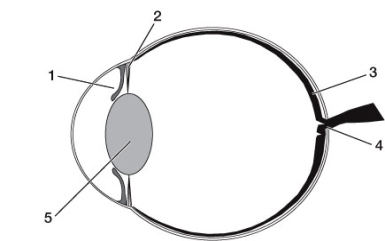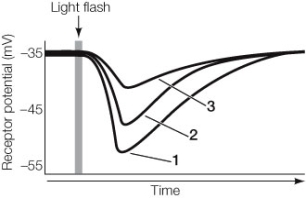Correct Answer

verified
Correct Answer
verified
Multiple Choice
You discover a new species of flatworm that you think may be a previously undiscovered species of planarian. One of the interesting things about planarians is their eyespots, which are able to absorb and detect photos of light. Which molecule would you look for that would indicate this new flatworm has eyespots?
A) Trypsin
B) Pheromones
C) G protein
D) Opsin
E) Rhodopsin
Correct Answer

verified
Correct Answer
verified
Multiple Choice
Image-forming, camera-like eyes are found in
A) flatworms.
B) cephalopods.
C) arthropods.
D) insects.
E) roundworms.
Correct Answer

verified
Correct Answer
verified
Multiple Choice
Which of the following statements about color vision is false?
A) There are three different types of cone cells in the human retina.
B) The absorption spectra of cone cells differ because of molecular differences in the retinal molecules.
C) Rods do not contribute to color vision.
D) The different rhodopsins in the human retina differ according to the range of wavelengths of light they absorb best.
E) Nocturnal animals often have poor color vision.
Correct Answer

verified
Correct Answer
verified
Short Answer
_______ are chemical signals used by individuals to communicate with other individuals of their species.
Correct Answer

verified
Correct Answer
verified
Multiple Choice
Compared to humans, dogs have a much more acute sense of smell due to the
A) larger amount of mucus in their noses.
B) larger surface area of their nasal epithelia.
C) greater density of their olfactory nerve endings.
D) larger number of capillaries in their noses.
E) typical canine body temperature.
Correct Answer

verified
Correct Answer
verified
Short Answer
The snake's forked tongue fits into cavities in the roof of its mouth that are richly endowed with olfactory sensors. Thus the snake uses its tongue to _______ its environment.
Correct Answer

verified
Correct Answer
verified
Multiple Choice
Which of the following statements about the compound eyes of arthropods is false?
A) Ommatidia are the optical units of compound eyes.
B) The number of ommatidia per eye can vary greatly in different species.
C) The eyes of cephalopods are similar to the compound eyes of arthropods.
D) The compound eye communicates a relatively crude image to the central nervous system.
E) Each ommatidium has a lens structure that directs light onto photoreceptors.
Correct Answer

verified
Correct Answer
verified
Multiple Choice
Refer to the diagram below of the eye. Which of the following incorrectly matches a labeled structure with the function it performs? 
A) Structure 1 - Controls the amount of light reaching photoreceptor cells
B) Structure 2 - Contracts to moves lens closer to or farther away from retina to focus image
C) Structure 3 - Area where density of cones is highest
D) Structure 4 - Area of the blind spot
E) Structure 5 - Allows the eye to accommodate
Correct Answer

verified
Correct Answer
verified
Multiple Choice
The advantage of communicating by means of extremely low-frequency sound waves is that
A) it permits coordination of attacks on prey.
B) these waves travel a very long distance.
C) the echoes of these waves bouncing back help locate prey.
D) the echoes of these waves bouncing back help in navigation.
E) All of the above
Correct Answer

verified
Correct Answer
verified
Multiple Choice
Which of the following statements about mechano-receptors is false?
A) Mechanoreceptors transduce mechanical forces into changes in receptor potential.
B) If a mechanoreceptor is subject to increased distortion, more ion channels within its membrane open.
C) Most mechanoreceptors are metabotropic sensory receptors.
D) If the receptor potential of a mechanoreceptor rises above a threshold, an action potential is propagated.
E) Stimulus strength determines the rate of generated action potentials.
Correct Answer

verified
Correct Answer
verified
Multiple Choice
A photoexcited molecule of rhodopsin
A) activates a G protein.
B) activates transducin.
C) leads to a chain of events which converts cyclic GMP (cGMP) to GMP.
D) Both a and b
E) a, b, and c
Correct Answer

verified
Correct Answer
verified
Multiple Choice
Monosodium glutamate (MSG) is often added to food as a flavor enhancer. It was recently discovered that MSG triggers the _______ taste.
A) sweet
B) sour
C) bitter
D) umami
E) salty
Correct Answer

verified
Correct Answer
verified
Multiple Choice
Refer to the graph below, showing the response of rod cells to flashes of light. Which of the following statements about the experiment depicted in the graph is true? 
A) It demonstrates that the membrane potential of rod cells is hyperpolarized in the dark.
B) It demonstrates that the membrane potential of rod cells is depolarized by light.
C) The stimulus that produces tracing 1 causes the rod cell to release more neurotransmitter than the stimulus that produces tracing 3.
D) The membrane potential depicted in tracing 3 shows the response to dim light.
E) None of the above
Correct Answer

verified
Correct Answer
verified
Multiple Choice
When a female sable antelope smells the urine of another female, a sample of nasal fluid is drawn over chemoreceptors of the _______, which is a structure located on the septum dividing the two nostrils.
A) gustatory nucleus
B) fovea
C) vomeronasal organ
D) organ of Corti
E) loop of Henle
Correct Answer

verified
Correct Answer
verified
Multiple Choice
The sound of the alarm clock in the morning triggers _______ in the sleeper.
A) an ionotropic sensory receptor
B) the opening of a pressure-sensitive cation channel
C) a metabotropic sensory receptor
D) a second messenger system
E) Both a and b
Correct Answer

verified
Correct Answer
verified
Multiple Choice
You discover a set of cells that transmits information from skin tissue to the CNS at the spinal cord. Assuming these cells receive internal and external information and deliver it to the CNS, what type of cells are they?
A) Motor cells
B) Action cells
C) Sensory cells
D) Glial cells
E) Chemoreceptors
Correct Answer

verified
Correct Answer
verified
Multiple Choice
Bright light shining directly into one's eye will trigger
A) an ionotropic sensory receptor.
B) the opening of a cation channel.
C) a metabotropic sensory receptor.
D) a second messenger system.
E) Both c and d
Correct Answer

verified
Correct Answer
verified
Multiple Choice
Which of the following does not employ hair cells as its transducer?
A) Meissner's corpuscle
B) Lateral line
C) Organ of Corti
D) Semicircular canal
E) Saccule
Correct Answer

verified
Correct Answer
verified
Multiple Choice
In the human visual system, _______ send information directly to the brain.
A) amacrine cells
B) bipolar cells
C) ganglion cells
D) rods and cones
E) horizontal cells
Correct Answer

verified
Correct Answer
verified
Showing 61 - 80 of 150
Related Exams